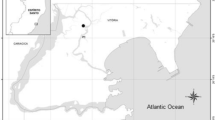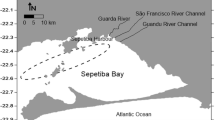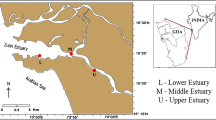Abstract
An extensive population of the burrowing crab, Neohelice granulata, inhabits the intertidal areas of the Bahía Blanca estuary, a moderately polluted temperate ecosystem located to the southwest of the province of Buenos Aires, Argentina. In order to determine the metal-accumulating ability of this species, concentrations of Cd, Cu, Pb, Ni, Zn, Mn, Cr, and Fe in soft tissues of adult specimens were measured. Subsequently, the bioconcentration factors (BCFs) of all heavy metals were determined using levels of concentrations previously obtained in intertidal sediments. The results showed concentrations above the detection limit in soft tissues of male and female crabs for all metals except Pb and Cr. BCF > 1 were obtained for Cd, Cu, and Zn, indicating that these metals are accumulated and biomagnified. However, BCF values < 1 were found for the rest of the metals (Mn, Ni, and Fe). The findings of metal accumulation in soft tissues of N. granulata is of great importance taking into account that this is a key species within this temperate ecosystem, playing a major role in the transference of pollutants to higher trophic levels.


Similar content being viewed by others
References
Ahmed K, Mehedi Y, Haque R, Mondol P (2011) Heavy metal concentrations in some macrobenthic fauna of the Sundarbans mangrove forest, south west coast of Bangladesh. Environ Monit Assess 177(1):505–514
Arias AH, Botello AV, Tombesi N, Ponce-Velez G, Freije J, Marcovecchio JE (2010) Presence, distribution, and origins of polycyclic aromatic hydrocarbons (PAHs) in sediments from Bahía Blanca estuary, Argentina. Environ Monit Assess 160:301–314
Ayas D (2013) Effects of gender and season on potentially toxic metal levels in muscles of adult blue swimmer crabs (Portunus pelagicus) from the northeastern Mediterranean Sea. J Mar Biol Oceanogr 2(2):2–4
Ayas D, Ozogul Y (2011) The effects of sex and seasonality on the metal levels of different muscle tissues of mature Atlantic blue crabs (Callinectes sapidus) in Mersin Bay, north-eastern mediterranean. Int J Food Sci Technol 46:2030–2034
Bergey LL, Weis JS (2007) Molting as a mechanism of depuration of metals in the fiddler crab, Uca pugnax. Mar Environ Res 64(5):556–562
Biancalana MF, Menéndez MC, Berazategui AA, Fernández Severini MD, Hoffmeyer MS (2012) Sewage pollution effects on mesozooplankton structure in a shallow temperate estuary. Environ Monit Assess 184(6):3901–3913
Bjerregaard P, Bjørn L, Nørum U, Pedersen KL (2005) Cadmium in the shore crab Carcinus maenas: seasonal variation in cadmium content and uptake and elimination of cadmium after administration via food. Aquat Toxicol 72:5–15
Bordon ICAC, Sarkis JES, Tomas ARG, Scalco A, Lima M, Hortellani MA, Andrade NP (2012) Assessment of Metal Concentrations in Muscles of the Blue Crab, Callinectes danae S., from the Santos Estuarine System. Bull Environ Contam Toxicol 89:484–488
Boschi EE (1964) Los crustáceos decápodos Brachyura del litoral bonaerense (R. A.). Bol Inst Biol Mar 6:1–75
Botté SE, Freije RH, Marcovecchio JE (2010) Distribution of several heavy metals in tidal flats sediments within Bahía Blanca estuary (Argentina). Water Air Soil Pollut 210:371–388
Chaiyaraa R, Ngoendeeb M, Kruatrachue M (2013) Accumulation of Cd, Cu, Pb, and Zn in water, sediments, and mangrove crabs (Sesarma mederi) in the upper Gulf of Thailand. ScienceAsia 39:376–383
Chen MH, Chen CY, Chou HY, Wen TC (2005) Gender and size effects of metal bioaccumulation on the rock crab, Thalamita crenata, in Dapeng Bay, southwestern Taiwan. Mar Pollut Bull 50(4):463–469
Cifuentes O, Escudero D, Medus S, Devoto B (2016) Cadmium found in the Bahía Blanca estuary. Int Educ Sci Res J 2(10):61–79
EPA- United States Environmental Protection Agency (2016) Definition and procedure for the determination of the method detection limit revision 2, EPA 821-R-16-006, 8pp
Escapa M, Perillo GME, Iribarne O (2008) Sediment dynamics modulated by burrowing crab activities in contrasting SW Atlantic intertidal habitats. Estuar Coast Shelf Sci 80:365–373
Ferrer LD (2001) Estudio de los diversos metales pesados en sedimentos del estuario de Bahía Blanca y sus efectos tóxicos sobre el cangrejo Chasmagnathus granulata. Doctoral thesis, Universidad Nacional del Sur, Bahía Blanca, Provincia de Buenos Aires
Ferrer LD, Andrade S, Asteasuain R, Marcovecchio JE (2006) Acute toxicities of four metals on the early life stages of the crab Chasmagnathus granulata from Bahia Blanca estuary, Argentina. Ecotoxicol Environ Saf 65:209–217
Galloway JN, Thronton JD, Norton SA, Volchok HL, McLean RAN (1982) Trace metals in atmospheric deposition: a review and assessment. Armos Environ 16(1):1677–1700
Gobas FAPC, Morrison HA (2000) Bioconcentration and biomagnification in the aquatic environment. In: Mackay D, Boethling RS (eds) Handbook of property estimation methods for chemicals: environmental health sciences. CRC Press, pp 189–197
Grecco LE, Gómez EA, Botté SE, Marcos ÁO, Marcovecchio JE, Cuadrado DG (2011) Natural and anthropogenic heavy metals in estuarine cohesive sediments: geochemistry and bioavailability. Ocean Dyn 61(2–3):285–293
Harris JM, Vinobaba1 P, Kularatne RKA, Kankanamge CE (2018) Heavy metal bioaccumulation and Fulton’s K condition indices in Scylla serrata (Forskål) in relation to sex. Int J Environ Sci Technol 1-10. https://doi.org/10.1007/s13762-018-1653-7
Ingersoll CG, Brumbauch WG, Dwyer FJ, Kemble NE (1994) Bioaccumulation of metals by Hyalella azteca exposed to contaminated sediments from the upper Clark Fork river, Montana. Environ Toxicol Chem 13(12):2013–2020
Ip CCM, Li XD, Zhang G, Wai OWH, Li YS (2007) Trace metal distribution in sediments of the Pearl River estuary and the surrounding coastal area, South China. Environ Pollut 147:311–323
Iribarne O, Bortolus A, Botto F (1997) Between-habitat differences in burrow characteristics and trophic modes in the southwestern Atlantic burrowing crab Chasmagnathus granulata. Mar Ecol Prog Ser 155:132–145
Jeckel WH, Roth RR, Ricci L (1996) Patterns of trace-metal distribution in tissues of Pleoticus muelleri (Crustacea: Decapoda: Solenoceridae). Mar Biol 125:297–306
Jones RP, Clarke JU (2005) Analytical chemistry detection limits and the evaluation of dredged sediment. ERDC/TN EEDP-04–36. United States Army Engineer Research and Development Center, Vicksburg
Kannan K, Yasunaga Y, Iwata H, Ichihashi H, Tanabe S, Tatsukawa R (1995) Concentrations of heavy metals, organochlorines, and organotins in horseshoe crab, Tachypleus tridentatus, from Japanese coastal waters. Arch Environ Contam Toxicol 28:40–47
Kumar Sharma R, Agrawal M, Marshall FM (2008) Atmospheric deposition of heavy metals (Cu, Zn, Cd and Pb) in Varanasi City, India. Environ Monit Assess 142:269–278
Limbozzi F, Leitao TE (2008) Characterization of Bahía Blanca main existing pressures and their effects on the state indicators for surface and groundwater quality. In: Neves R, Baretta JW, Mateus M (eds) Perspectives on integrated coastal zone management in South America. IST Press, Lisboa
Louis Y, Garnier C, Lenoble V, Omanović D, Mounier S, Pizěta I (2009) Characterisation and modelling of marine dissolved organic matter interactions with major and trace cations. Mar Environ Res 67:100–107
Luppi TA, Spivak ED, Bas CC, Anger K (2004) Molt and growth of an estuarine crab, Chasmagnathus granulatus (Brachyura: Varunidae), in Mar Chiquita Lagoon, Argentina. J Appl Ichthyol 20:333–344
MacFarlane GR, Booth DJ, Brown KR (2000) The semaphore crab, Heloecius cordiformis: bioindication potential for heavy metals in estuarine systems. Aquat Toxicol 50:153–166
Marcovecchio JE, Ferrer L (2005) Distribution and geochemical partitioning of heavy metals in sediments of the Bahía Blanca estuary, Argentina. J Coast Res 21:826–834
Marcovecchio JE, Freije RH (2004) Efectos de la intervención antrópica sobre sistemas marinos costeros: El estuario de Bahía Blanca. Anales de la Academia Nacional de Ciencias Exactas, Físicas y Naturales (ANCEFN). Argentina 56:115–132
Marcovecchio JE, Spetter CV, Botté SE, Delucchi F, Arias AH, Fernández Severini MD, Negrin V, Popovich C, Freije RH (2009) Inorganic nutrients and organic matter tidal time-scale variation in a mesotidal estuary: Bahıa Blanca, Argentina. Chem Ecol 25(6):453–465
Marsden ID, Rainbow PS (2004) Does the accumulation of trace metals in crustaceans affect their ecology-the amphipod example? J Exp Mar Biol Ecol 300:373–408
Mendoza- Carranza M, Sepúlveda-Lozada A, Dias-Ferreira C, Geissen V (2016) Distribution and bioconcentration of heavy metals in a tropical aquatic food web: a case study of a tropical estuarine lagoon in SE Mexico. Environ Pollut 210:155–165
Mountouris A, Voutsas E, Tassios D (2002) Bioconcentration of heavy metals in aquatic environments: the importance of bioavailability. Mar Pollut Bull 44:1136–1141
Na CK, Park HJ (2012) Distribution of heavy metals in tidal flat sediments and their bioaccumulation in the crab Macrophthalmus japonicas in the coastal areas of Korea. Geosciences J 16(2):153–164
Oliva AL, Quintas PY, La Colla NS, Arias AH, Marcovecchio JE (2015) Distribution, sources, and potential Ecotoxicological risk of polycyclic aromatic hydrocarbons in surface sediments from Bahía Blanca estuary, Argentina. Arch Environ Contam Toxicol 69(2):163–172
Olusegun AO, Olukemi TO, Olukemi MB (2009) Heavy metal distribution in crab (Callinectes amnicola) living on the shores of Ojo Rivers, Lagos, Nigeria. Environmentalist 29(1):33–36
Perillo GME, Piccolo C, Parodi E, Freije RH (2001) Bahía Blanca estuary, Argentina. In: Seeliger U, Kjerfve B (eds) Coastal marine ecosystems of Latin America, ecological studies, vol 144. Springer, Berlin, pp 205–217. https://doi.org/10.1007/978-3-662-04482-7
Perry H, Isphording W, Trigg C, Riedel R (2015) Heavy metals in red crabs, Chaceon quinquedens, from the Gulf of Mexico. Mar Pollut Bull 101:845–851
Piccolo MC, Perillo GME, Melo W (2008) The Bahía Blanca estuary: an integrated overview of its geomorphology and dynamics. In: Neves R, Baretta JW, Mateus M (eds) Perspectives on integrated coastal zone management in South America. IST Press, Lisboa, pp 219–229
Qiu (2015) Bioaccumulation of heavy metals both in wild and mariculture food chains in Daya Bay, South China. Est Coast Shelf Sci 163:7–14
Rainbow PS (1997) Trace metal accumulation in marine invertebrates: marine biology or marine chemistry. J Mar Biol Assoc U K 77:195–210
Rainbow PS (2002) Trace metal concentrations in aquatic invertebrates: why and so what? Environ Pollut 120:497–507
Sabin LD, Lim JH, Stolzenbach KD, Schiff KC (2005) Contribution of trace metals from atmospheric deposition to stormwater runoff in a small impervious urban catchment. Water Res 39:3929–3937
Shank GC, Skrabal SA, Whitehead RF, Kieber RJ (2004) Strong copper complexation in an organic-rich estuary: the importance of allochthonous dissolved organic matter. Mar Chem 88:21–39
Simonetti P, Botté SE, Fiori SM, Marcovecchio JE (2012) Heavy-metal concentrations in soft tissues of the burrowing crab Neohelice granulata in Bahía Blanca estuary, Argentina. Arch Environ Contam Toxicol 62:243–253
Simonetti P, Botté SE, Fiori SM, Marcovecchio JE (2013) Burrowing crab (Neohelice granulata) as a potential bioindicator of heavy metals in the Bahía Blanca estuary, Argentina. Arch Environ Contam Toxicol 64:110–118
Simonetti P, Botté SE, Macrovecchio JE (2017) Occurrence and spatial distribution of metals in intertidal sediments of a temperate estuarine system (Bahía Blanca, Argentina). Environ Earth Sci 76:636
Spivak ED (1997) Cangrejos estuariales del Atlantico sudoccidental (25°-41°S) (Crustacea: Decapoda: Brachyura). Invest Mar Valparaıso 25:105–120
Sundaray SK, Nayak BB, Lin S, Bhatta D (2011) Geochemical speciation and risk assessment of heavy metals in the river estuarine sediments—a case study: Mahanadi basin, India. J Hazard Mater 186(2–3):1837–1846
Town RM, Filella M (2002) Implications of natural organic matter binding heterogeneity on understanding lead (II) complexation in aquatic systems. Sci Total Environ 300:143–154
Tsui MTK, Wang WX, Chu LM (2005) Influence of glyphosate and its formulation (Roundup®) on the toxicity and bioavailability of metals to Ceriodaphnia dubia. Environ Pollut 138:59–68
Vassiliki K, Konstantina AD (1984) Transfer factors of heavy metals in aquatic organisms of different trophic levels. Bull Environ Contam Toxicol 33:423–429
Wang WX, Fisher NS (1999) Delineating metal accumulation pathways for marine invertebrates. Sci Total Environ 237(238):459–472
White SL, Rainbow PS (1985) On the metabolic requirements for copper and zinc in molluscs and crustaceans. Mar Environ Res 16:215–229
Wong CSC, Li XD, Zhang G, Qi SH, Peng XZ (2003) Atmospheric deposition of heavy metals in the Pearl River Delta, China. Atmos Environ 37(6):767–776
Yang Y, Chen F, Zhang L, Liu J, Wu S, Kang M (2012) Comprehensive assessment of heavy metal contamination in sediment of the Pearl River estuary and adjacent shelf. Mar Pollut Bull 64:1947–1955
Acknowledgments
We thank N. Buzzi, F. García, and J. Pons for their collaboration both in the field work and in the laboratory and W. Melo for providing the map and collaborating with figures elaboration. We also thank the IADO executive directors and Chemical Oceanography Area’s staff.
Funding
This investigation was supported by the National Council for Scientific and Technological Research (CONICET; PIP No. D-738/2010 and Resol. No. 4541/12), the National Agency for Promotion of Science and Technology (ANPCyT: PICT 2012–1383, 2012–2794, 2014–3364, and 2015–2076), and the Science and Technical Secretary of the Universidad Nacional del Sur (PGI 24/ZB59), all from Argentina.
Author information
Authors and Affiliations
Corresponding author
Additional information
Responsible editor: Philippe Garrigues
Rights and permissions
About this article
Cite this article
Simonetti, P., Botté, S.E. & Marcovecchio, J.E. Heavy metal bioconcentration factors in the burrowing crab Neohelice granulata of a temperate ecosystem in South America: Bahía Blanca estuary, Argentina. Environ Sci Pollut Res 25, 34652–34660 (2018). https://doi.org/10.1007/s11356-018-3404-1
Received:
Accepted:
Published:
Issue Date:
DOI: https://doi.org/10.1007/s11356-018-3404-1




